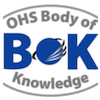Chapter 31.1: Risk
Abstract
The purpose of this chapter is to discuss the meaning of risk in its broader organisational and societal context and the implications this has for managing occupational health and safety (OHS) risks. Risk is a complex concept, but we often try to describe a risk in only a few words and represent its magnitude as a single value. The validity of the assumptions normally made in recording and assessing risks are explored with a quantitative example used to explain some of the problems. The most important part of managing risks in the workplace is not to measure it (qualitatively or quantitatively) but to understand the nature of risks, their causes and consequences and to use this information to control risks. This chapter aims to explore terminology issues, discuss the concept of risk and how risk is assessed then consider how to apply a risk management process in a safety context.
Keywords: Occupational Health and Safety, OHS, risk, uncertainty, likelihood, consequence, risk assessment, risk analysis, level of risk, risk management
First year of publication: 2012
Current Version : 2019
Chapter 31.1: Risk
Table of contents
| 1 | Introduction |
| 1.1 | Hazards and Risks |
| 2 | Definitions of Risk |
| 2.1 | Risk as a description |
| 2.2 | Risk as a measure |
| 3 | Estimating a level of risk |
| 3.1 | Introduction |
| 3.2 | The value of consequences |
| 3.3 | Issues with defining likelihood |
| 3.4 | How consequence and likelihood are combined |
| 3.5 | Risks with multiple possible values of consequence |
| 3.6 | Risks with multiple types of consequence |
| 3.7 | Risks with gradual or time delayed consequences |
| 3.8 | Qualitative considerations |
| 4 | Risk and decisions |
| 4.1 | Defining Acceptable level of risk |
| 5 | Implications for practice |
| 5.1 | Definitions of risk |
| 5.2 | Risk management |
| 5.3 | Risk assessment |
| 5.4 | Risk Treatment |
| 6 | Summary |
| References |
Professor Jean Cross Bsc PhD FIE Aust MAIRM.FSIA(Hon)
Emeritus Professor Risk and Safety Sciences, University of New South Wales
Professor Cross has a degree and PhD in physics obtained in the UK. She has was involved in research and consulting work in the fields of electrostatics (hazards and applications), dust explosions and air pollution control before taking up an appointment as chair of Safety Engineering at UNSW in 1988 where she taught safety risk management for 20 years. She has also been involved in standards development in the field of risk management and reliability. She was chair of the Australian standards committee that developed AS4360 Risk Management from 1992 until 2004 She retired from UNSW in 2008 but continues with some teaching and with standards work.
Peer reviewers
Dr Keith Adam MBBS, AFOEM
Senior Occupational Physician, Medibank Health Solutions, Queensland
Sally Bennett BSc, GDipChemEng, GDipOHM, MBA, CPMSIA
Director, Enhance Solutions; Sessional Lecturer, Deakin University; President, Victorian Chapter, Risk Management Institute of Australia.
Associate Professor Andrew Morrell Beng, GDipMgt
Minerals Industry Risk Management, Minerals Industry Safety and Health Centre, University of Queensland
Learning Outcomes: Risk
The OHS Body of Knowledge takes a conceptual approach which enables it to be applied in different contexts and frameworks. To optimise its value for education and professional development learning outcomes have been developed for each technical chapter in the Body of Knowledge.
The learning outcomes as described give an indication of what should be the capabilities of a new graduate OHS professional in the workplace. I t is up to those developing OHS education programs, OHS professionals planning their CPD or recruiters or employers selecting or developing people for the OHS function to consider the required breadth vs. depth
Podcast
Safety of Work Podcast: Episode 8 Do risk matrices help us make better decisions”
The discussion draws on the papers Further Thoughts on the Utilities of Risk Matrices and Whats wrong with risk matrices.
Date: 2020
Presenters: Drew Rae & David Provan
Source: https://www.safetyofwork.com/episodes/ep8-do-risk-matrices-help-us-make-better-decisions
Safety of Work Podcast: Ep 63: How subjective is technical risk assessment?
Risk matrices. Why the paper we reference is a trustworthy source. Scoring risks. How objective are we? How to interpret risk scores. What the risk-rating is dependent upon.
Date: 2021
Presenters: Drew Rae & David Provan
Source: https://safetyofwork.com/episodes/ep-63-how-subjective-is-technical-risk-assessment
Safety of Work Podcast: Ep 40: When should we trust expert opinion about risk?
What we mean by “expertise”. Forecasting. Determining the value of a given expert. Biases in reporting and researching. Super-forecasting. Wisdom of crowds. Better ways to get better answers. Why mathematical models aren’t as helpful as we think.
Date: 2021
Presenters: Drew Rae & David Provan
Source: https://safetyofwork.com/episodes/ep40-when-should-we-trust-expert-opinions-about-risk
Webinars
IChemE ISC: Ep 40: Remote and virtual risk assessment – impacts of COVID-19
Discussion on current best practices for managing risk assessments during the COVID-19 pandemic.
Date:
Presenters: Trish Kerrin
Source: https://www.youtube.com/watch?v=j3F-8BuZ9tA

